Mughal Mirror/Table Diamond Necklace
Open FREE Unlimited Store Join Our Newsletter
Dr Shihaan Larif
Origin of Name
The antique diamond and emerald necklace has no doubt features of the classic Mughal period dating from 1556 to 1707, such as the antique table-cut/mirror-cut of the diamonds, the fluted emerald drops and the silk thread used for stringing the diamond and emerald pendant/fringes together. Such diamond and emerald ornaments besides being used as a necklace, could also be tied as arm bands or as an ornament on the turban, and formed an important part of the Mughal jewelry collection. Hence, the name "Mughal Mirror Diamond Necklace" not only reflects the period of origin of the necklace, but also refers to the most important component of the necklace, viz. the mirror/table diamonds.
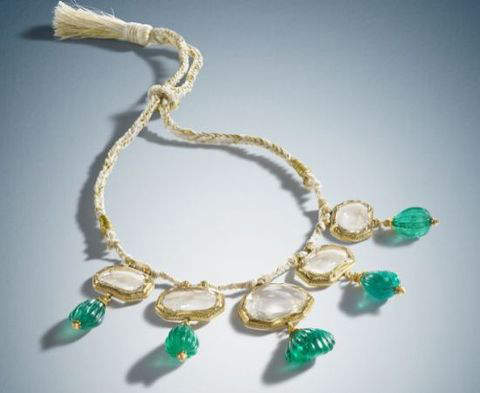
Mughal Mirror Diamond Necklace
Characteristics of the Necklace
Features of the antique necklace/arm band as a whole
The late 16th to early 18th century antique necklace/arm band is made up of five fringes/pendants strung together by a twisted silk cord as most other necklaces of this period. Each fringe/pendant is made up of a large, almost octagonal-shaped, table-cut (mirror/portrait/lasque) diamond, surrounded by an octagonal-shaped yellow-gold bezel. Two yellow-gold loops are fixed on opposite sides of the octagonal-bezel; the upper-loop used for passing the twisted silk cord and the lower-loop for suspending the fluted emerald drops, each provided with a gold cap. The central pendant is the largest of the five pendants. Similar but smaller pendants are placed at symmetrical positions on either side of the central pendant. Likewise, the largest table diamond is incorporated in the central pendant and matching but slightly smaller table diamonds are placed on either side in symmetrical positions.
Characteristics of the table diamonds

Enlarged Central Diamond of the Necklace weighing 28 carats
Carat weight of the diamonds
The five table diamonds in the Mughal Mirror Diamond Necklace are the largest known matching set of table diamonds from the Mughal classic period. The total weight of the diamonds is approximately 96 carats. The weight of the five diamonds ranges from 16 to 28 carats. The largest table-cut diamond measures 24.3 mm across and weighs 28 carats, and is believed to be the largest table/lasque/portrait/mirror diamond in existence in the world today. Another famous table diamond, the pear-shaped, Russian Table Portrait Diamond incorporated as the centerpiece of a Gothic style bracelet, weighs 27 carats.

Mirror Diamond immediately on the left side of the Central Diamond
Color Grade of the diamonds
The Gemological Institute of America has assigned a color-grade of near-colorless to the diamonds, which ranges between G and J. G,H,I,and J diamonds contain traces of yellow color, not easily detected by the naked eye. An examination of the enlarged photographs of the diamonds show that they are apparently absolutely colorless diamonds that fall under the color grades D to F. However, careful examination with a 10x magnification hand lens would reveal the traces of yellow color.
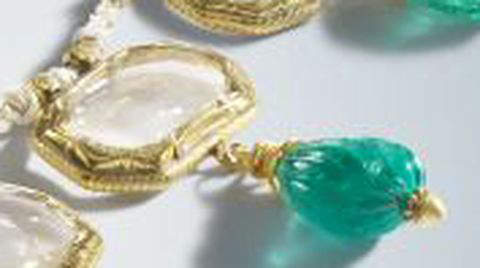
Mirror Diamond immediately on the right side of the Central Diamond
Cut of the diamonds
All five diamonds are table-cut also known as lasque, portrait diamond or mirror diamond. Table-cut diamonds are thin diamond sections, with a flat top and flat bottom. The diamonds can take any shape, such as rectangle, square, polygonal etc. In this case except for the central diamond, the remaining four table-cut diamonds are approximately octagonal in shape. The central large diamond has 9 or 10 sides. The edges of the diamond are also faceted, and fits into the octagonal-shaped bezels. Such flat and transparent diamonds were also used in miniature portrait settings and hence the name portrait diamond. Please click the following link to visit our webpage on the famous Russian Table Portrait Diamond.
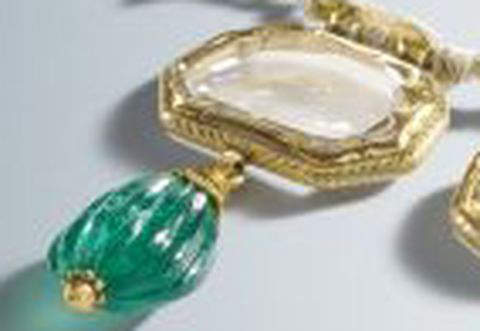
Mirror Diamond at the extreme left-side of the necklace
Clarity-grade of the diamonds
The exact clarity-grade of the diamonds are not known. However, being Golconda diamonds the clarity of the diamonds should be exceptional. In enlarged photographs the table-cut diamonds appear to be eye clean. Since the diamonds are flat and wide on both sides, any inclusions inside should be clearly visible. The fact that no such inclusions are visible may be indicative of their high clarity grade. However, nothing could be said certainly of the clarity, as all clarity grades are based on the visibility of inclusions under 10x magnification.
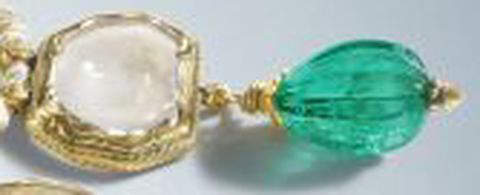
Mirror diamond at the extreme right-side of the necklace - the smallest diamond in the necklace weighing 16 carats
The Mirror diamonds are Type 1aAB diamonds
Being near-colorless diamonds with color grades varying from G to J, all five mirror diamonds in the necklace are Type Ia diamonds. These diamonds are Type I because they have detectable quantities of nitrogen in them. Type I diamonds where the nitrogen atoms exist as aggregates of 2. 3, or 4 atoms are known as Type Ia diamonds. If nitrogen atoms are found as single scattered atoms, the diamonds are Type Ib. 98% of all natural diamonds are Type Ia. Type Ib diamonds constitute only about 0.1% of all natural diamonds.
Type Ia diamonds are further subdivided into three :-
1) Type IaA - Nitrogen atoms are found as aggregates of 2 atoms, known as A-aggregates. A-aggregates do not absorb visible light and therefore do not affect the color of the diamond. A-aggregates also quench fluorescence. Therefore type IaA diamonds are colorless and non-fluorescent.
Type IaB :- Nitrogen atoms are found as aggregates of 4 atoms, known as B-aggregates. B-aggregates do not absorb visible light, and do not affect the color of the diamond. They cannot quench fluorescence and therefore Type IaB diamonds are colorless and strongly fluorescent.
Type IaAB :- Nitrogen atoms are found as A-aggregates, B-aggregates, and aggregates of 3 atoms known as N3 centers. A and B aggregates do not affect the color of the diamonds but N3 centers do. N3 centers absorb visible light in the blue end of the spectrum giving rise to a pale to medium yellow color. The diamonds also show some fluorescence.
98% of all natural diamonds come under the sub-group Type IaAB. These diamond have a range of yellow colors, varying from near-colorless to light-yellow colors. The color gradings are as follows :-
1) Near-Colorless - Grade G, H, I, J
2) Faint Yellow - Grade K, L, M
3) Very Light-Yellow - Grade N, O, P, Q, R
4) Light Yellow - Grade S, T, U, V, W, X, Y, Z
The superior transparency and luminosity of Golconda diamonds
Golconda diamonds have a superior transparency and luminosity, variously referred to as soft, limpid, watery or pure, rarely seen in diamonds from other sources. The degree of transparency of these diamonds, not to be confused with clarity or being free from flaws, allows the free unimpeded passage of light, as if it were passing through a vacuum. The surface luster is soft and gentle, but luminous and striking. The Mughal Mirror diamonds, even though, not absolutely colorless, but described by GIA as near-colorless, possess the superior qualities of transparency and luminosity found in D-color Golconda diamonds.
Speculation by the GIA that all five mirror diamonds were cut from the same crystal.
The GIA has speculated that all the five near-colorless, Golconda, table-cut diamonds were possibly cut from the same crystal. The main lines of evidence for this speculation are :-
1) The identical almost octagonal shape of all the five mirror diamonds that fitted into octagonal-shaped yellow-gold bezels.
2) The same color-grade of the diamonds.
3) The same clarity grade of the diamonds.
4) The same transparency and luminosity of the diamonds.
Crystal habits of natural diamonds
Crystal habits that conform to the cubic crystal system
Diamond crystalizes in the cubic or Isometric crystal system, in which the basic crystal structure is a face-centered cubic lattice (FCC). which can build up into a variety of crystal forms or habits, such as cubic (6 square faces), octahedron (8 triangular faces), dodecahedron (12 regular pentagonal faces), cubo-octahedron (14-faces - 6 square faces, 8 triangular faces), rhombic dodecahedron ( 12 rhombic faces), hexoctahedron or disdyakisdodecahedron ( 48 triangular faces) etc.
The commonest crystal form seen in diamonds is the octahedron. The cubic form is less common. Other rare forms include the dodecahedron, the truncated cube, cubo-octahedron, rhombic dodecahedron, Hexoctahedron or Disdyakisdodecahedron etc.
1) The Octahedron - Commonest Diamond Crystal Habit

The Octahedron - Commonest diamond crystal form
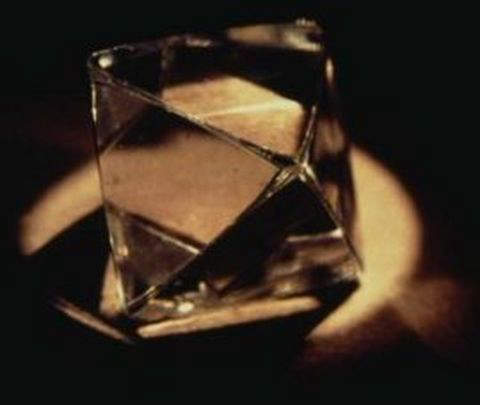
Octahedral diamond crystal - the most common crystal habit in diamonds
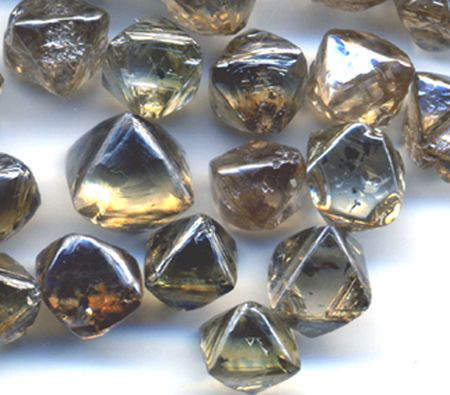
Natural Octahedral Rough Diamonds
https://www.rockdeco.com/DIAMOND%20LINK%20PAGE.htm
2) The Cubic Crystal Habit - Less Common than the Octahedron

The Cube - rare diamond crystal form

Cubic diamond crystals from Zaire in Africa
https://www1.newark.ohio-state.edu/Professional/OSU/Faculty/jstjohn/default.htm

Cubic and octahedral crystal habits of diamonds from Africa
https://www1.newark.ohio-state.edu/Professional/OSU/Faculty/jstjohn/default.htm
3) The Dodecahedron - Less Common Crystal Habit of Diamonds

The Dodecahedron - Less common diamond crystal form
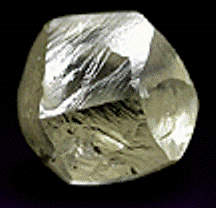
Rare dodecahedral diamond crystal
https://www.johnbetts-fineminerals.com
4) The Cubo-Octahedron - Rare Diamond Crystal Habit

The Cubo-Octahedron - Rare diamond crystal form
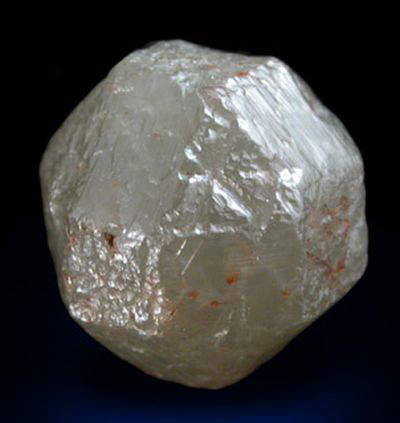
Cubo-Octahedral Diamond Crystal
https://www.johnbetts-fineminerals.com/jhbnyc/mineralmuseum/picshow.php?id=35674
5) An extremely rare cubo-octahedral-dodecahedral diamond crystal
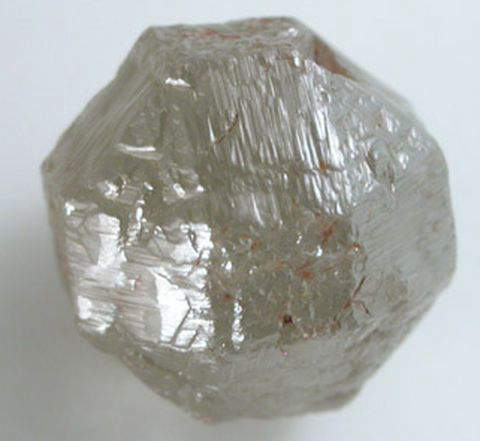
Rare Cubo-Octahedral-Dodecahedral Diamond Crystal with 26 faces.
The rare cubo-octahedral-dodecahedral diamond crystal from John Betts collection has 26 faces - 14 faces of the Cubo-Octahedron and 12 faces of the Dodecahedron. The outline of the diamond is an Octagon.
6) Disdyakisdodecahedron - Hexoctahedron - Rare diamond crystal habit

Disdyakisdodecahedron - rare diamond crystal form
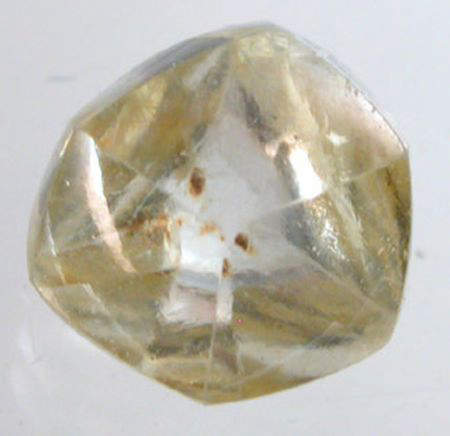
Hexoctahedral Diamond Crystal
https://www.johnbetts-fineminerals.com/jhbnyc/mineralmuseum/picshow.php?id=35856
Crystal habits that do not conform to the cubic crystal system
Diamonds can also form crystal habits that do not conform to the cubic crystal system. They can form twinned crystals, and can exist as cleavage fragments and unshaped distorted fragments. Some twinned crystals and cleavage fragments assume a triangular shape known as macles. These crystals often have curved faces. Diamonds can also form etched crystals having rounded surfaces and sometimes elongated shapes. Real diamond crystals don't have completely smooth faces, but may have raised or indented triangular growths called 'trigons'.
Macles and etched crystals are crystal habits that do not conform to the cubic crystal system
1) Diamond Macles

Flat triangular diamond macles - do not conform to the cubic crystal system
https://research.eas.ualberta.ca/drg/Gallery.html
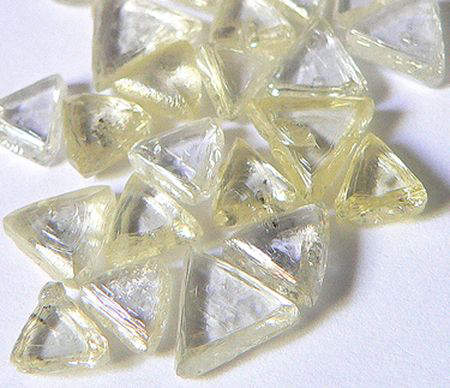
Natural Rough Diamond Macles
https://www.rockdeco.com/DIAMOND%20LINK%20PAGE.htm
2) Etched Diamond Crystals
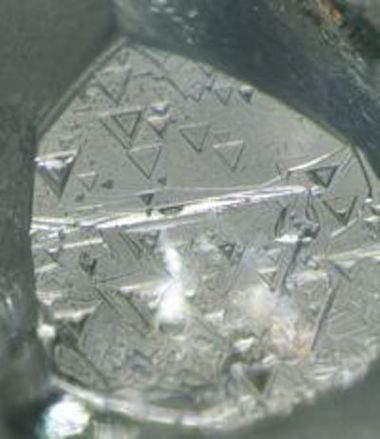
Etched trigons on the surface of the diamond crystal
https://research.eas.ualberta.ca/drg/Gallery.html
What is the possible crystal habit of the single diamond crystal from which the five mirror diamonds of the Mughal Mirror Diamond Necklace was cut, as speculated by the GIA
If the GIA speculation that all five mirror diamonds were cut from a single crystal is correct, what is the crystal habit of the natural diamond crystal from which the diamonds were cut ? This is a difficult question to answer, given the antiquity of the diamonds and the limited tools that were at the disposal of the ancient diamond cutter. However, splitting diamonds along cleavage planes is a technique the ancient diamond cutter had mastered by trial and error. Hence, any crystal habit that could qualify as the mother crystal from which the five satellite table-cut diamonds originated, should have cleavage planes that would facilitate the splitting-up of the diamonds. However, all diamond crystal habits that conform to the isometric or cubic crystal system, have only one type of cleavage, viz. an octahedral cleavage that results in octahedral fragments. Hence, it is not possible for a mother crystal to form five table-cut, octagonal-shaped diamonds by cleavage alone.
The next possibility is the cutting of the mother crystal, by sawing, into five table-cut flat diamonds. However, sawing was first introduced in the west in the mid-17th century, and perhaps in India a little earlier. The method consisted in coating a thin wire with diamond powder mixed with oil, which is then run across the stone at the desired points on the diamond. The method was very tedious and time consuming but was the only method available until the 19th-century.
The possible crystal habits conforming to the isometric crystal system, that was perhaps used for sawing the five almost-octagonal-shaped table-cut diamonds are 1) the Hexoctahedral or Disdyakisdodecahedron diamond crystal, whose outline is 10-sided 2) the Cubo-Octahedral diamond crystal whose outline is 8-sided or 3) the extremely rare Cubo-octahedral-dodecahedral diamond crystal whose outline is 8-sided.
Hence, the fact that sawing was used in cutting the five Mughal Mirror diamonds, the period of origin of the necklace can be estimated to be after early 17th-century, which would correspond with the period of rule of Emperor Jahangir (1605-1627), or Emperor Shah Jahan (1628-1658) or Emperor Aurangzeb (1658-1707).
The source of the fluted emerald drops on the necklace
Discovery of the Chivor and Muzo Emerald Mines by the Spanish Conquistadors
The source of the fluted emerald drops on the necklace is undoubtedly Columbia, the main source of emeralds to the world, since the discovery of emeralds in the New World, by Spanish conquistadors in 1537. The first emerald mine that was discovered by the Spanish in Columbia in 1537 was the Somondoco/Chivor emeral mine, high up in the Andes Mountains about 70 miles northeast of Bogota. After subduing the Chibchan Indians in whose territory the Somondoco/Chivor mine was situated, the Spanish began their exploitation in the 1540s, despite the inhospitable terrain and the inaccessibility of the region. The mines were exploited for more than 100 years until 1675 when King Charles II of Spain was forced to issue a royal decree closing down the mines indefinitely, due to the incredibly cruel conditions under which the mines were operated. The abandoned Chivor mines were lost for the next 200 years, when the surrounding jungle reclaimed the area, until rediscovered in 1896 by the mining engineer Don Francisco Restrepo.
The Spanish discovered the Muzo emerald mines only in 1594 after partially subduing the Muzo Indians in 1555. Exploitation of the Muzo mines began in earnest in 1594 and during the first 15 years a substantial output was obtained from these mines. However, production began to decline subsequently, due again to cruel conditions at the mines, such as compulsory labor imposed on the neighbouring tribes, long working hours, cruelty and maltreatment, resulting in high mortality rate among the workers. The status quo continued until the mid-18th-century, with little or no increase in production, until a disastrous fire in the mines put a stop to all mining activites. The mines were abandoned and recommenced production only in 1819, after Columbia gained independance from the Spanish.
How the Colombian emeralds eventually reached the Mughal Empire ?
The production of the Chivor Emerald Mine (1540s -1675) and the Muzo Emerald Mine (1594-1750) eventually found their way to Spain. After the emeralds reached Spain, and the Royal family of Spain had taken their share of the emeralds, the remainder was exported to countries in Europe, and the three Islamic monarchies of the Middle East and India, the Ottoman Empire, the Persian Empire and the Mughal Empire. Emeralds bound for the Mughal Empire in India, would have been carried by vessels around the Cape and across the Indian Ocean and Arabian Sea to ports on the west coast of the Indian sub-continent. Another possible route for the emeralds would have been across the Pacific from the port city of Acapulco in Mexico, by the Pacific Fleet which reached China and later the east coast India via the Philippines.
Why the Spanish preferred to send a substantial quantity of the emerald production of Colombia to the Mughal Court ?
The extravagance displayed at the Mughal courts was no doubt an indicator of the vast amount of wealth concentrated in the empire, and the Spanish colonialists who controlled the emeralds mines of Colombia during this period were well aware of this. Thus, it might not be surprising why the Spanish preferred to send a significant quantity of the annual production of emeralds from the mines of Colombia to the courts of the Mughal empire, rather than the courts of European monarchies, as this was where the wealth of the world seem to be concentrated at that time. The Spanish received gold and silver bullion in exchange for the emeralds from the Mughal empire, which was indeed "hard currency" for the Spanish government. Enormous quantities of emeralds from Colombia, thus ended up in the Mughal empire, where they were cut and polished or engraved and set in jewelry by Indian craftsmen, for the Emperor and members of the royal household, the noble classes and other rich families. The emperors extended their patronage to the jewelry crafting industry, and several townships sprung up in the empire, such as the city of Jaipur, where the craftsmen settled and engaged in their trade.
The fluted emerald beads incorporated in the Mughal Mirror Diamond Necklace are no doubt of Indian origin and possibly from the same classic Mughal period
In the book, "Cartier" written by Hans Nadelhoffer it is stated that, From 500 A.D. to around 1500 A.D. India was the world's principal supplier of beads, with exports to Arabia, Egypt, Persia and Europe. India's monopoly on beads was broken only with the advent of the agate industry of Idar-Oberstein in Germany and the glass-bead industry of Venice.
The Indian bead industry was based on a number of gemstones not only sourced from India, but also from countries like neighbouring Sri Lanka, Burma, Afghanistan, and from countries as far as Colombia. The Indian jewel craftsmen mastered the art of converting Colombian emeralds to beads, not only using cabochon emeralds, but also engraved or fluted emeralds. Hence, the fluted emerald beads incorporated in the Mughal Mirror Diamond Necklace are no doubt of Indian origin and most probably from the classic period of the Mughal empire, when the jewelry crafting industry under royal patronage reached an advanced state.
History of the Diamond Necklace
Early History of the Diamonds
Source of the Mirror Diamonds - Kollur diamond mines near Golconda
Being incorporated in a late-16th-century to early-18th-century antique Mughal necklace, the table-cut mirror diamonds are undoubtedly of Indian origin, the only source of diamonds in the world around that period. The diamonds are believed to have originated in the famous alluvial diamond mines in Kollur near Golconda, in Southern India, which were discovered in the mid-16th-century around 1540-1560 A.D. Most of the Kollur mines were extraordinarily rich, and produced the best quality colorless as well fancy colored diamonds, such as pink, blue and yellow. Golconda diamonds were renowned for their color and clarity, that the name Golconda entered the terminology in the past to refer to the best quality diamonds irrespective of their country of origin.
The possible locations in the world, where the Golconda diamonds eventually ended up, and the modus operandi of their export
Golconda was the capital of the Qutb Shahi Kingdom, one of the five Muslim Sultanates of the Deccan region of India, from 1512 to 1687. The diamond mines of Golconda were fully exploited during this period, possibly assisted by the expertise and ready markets provided by the Persians, with whom they had close cultural and economic ties. The diamonds mined during this period at Golconda, eventually ended up in three possible locations:- (1) The capital of the Persian Empire, (2) The capital cities of Agra and Delhi of the Mughal Emperors, (3) The capital cities of different monarchies of Europe, such as London, Paris, St. Petersburg, Florence, Austria-Hungary, Madrid, Lisbon, Amsterdam, etc. Many Persian and European diamond dealers who were active in the areas of Golconda and other diamond producing mines on the eastern side of the Deccan Plateau were responsible for much of the movement of diamonds to the West and Persia. Even Jean Baptiste Tavernier, the 17th-century French traveler and jeweler who made up to six trips over a period of 40 years, and visited the diamond producing areas of Golconda, and the diamond cutting centers of Ahmedabad, was partly responsible for the movement of many notable diamonds to the capital cities of Western monarchies.
The classic period of the Mughal empire, a golden period of the history of India during which the arts, architecture, literature and other cultural activites flourished, and jewelry designing attained new heights under royal patronage
The Classic period of the Mughal empire extends from 1556, the year of ascension of Akbar the Great to the Mughal throne until 1707. the year of demise of Aurangzeb, the last of the Great Mughal emperors. The four mighty emperors of this period are 1) Akbar the Great (1556-1605), 2) Nur-ud-Din Muhammad Jahangir, (1605-1627) 3) Shah Jahan (1628-1658), 4) Muhi-ud-Din Mohammed Aurangzeb (1658-1707). The Classic period of the Mughal Empire is considered as the golden period in the history of India, during which the arts, architecture, literature and other cultural activities flourished, and jewelry designing and crafting became a highly skilled and refined art, attaining new heights, under royal patronage. The Mughal Mirror Diamond Necklace is believed to be a product of this golden era.
The general notion that all diamonds produced in the Kollur diamond mines and other diamond mines of the eastern Deccan plateau, automatically entered the treasury of the Mughal emperors is totally erroneous and historically inaccurate
The Classic period of the Mughal empire (1556-1707) falls within the period of rule of the Qutb Shahi kingdom in Golconda (1512-1687) except, except for 20 years from 1687 to 1707. Hence. the Kollur diamond mines of Golconda were under the jurisdiction and control of the Qutb Shahi rulers during this period, save for a period of 20 years during the reign of Emperor Aurangzeb (1658-1707) when the kingdom was captured and annexed to the Mughal empire. The region remained under Mughal rule until 1724, when Mir Qamar-ud-Din, the viceroy of the Mughals for the Deccan region, also known as Asaf Jah, declared independence and founded the Kingdom of Hyderabad. Mir Qamar-ud-Din founded the dynasty of the Nizams of Hyderabad, and is known as the Nizam-ul-Mulk. Thus, the Golconda diamond mines were under the directly control of the Mughal empire only for a period of 37 years from 1687 to 1724, after which the mines came under the control of the Nizams of the Kingdom of Hyderabad.
Hence, the general notion that all diamonds produced in the Kollur diamond mines and other diamond mines of the eastern Deccan plateau, automatically entered the treasury of the Mughal emperors is totally erroneous and historically inaccurate. The Mughal emperors too had to pay in hard cash, mainly in the form of gold or silver, for their supplies of diamond from the Kollur diamond mines.
How did the Mughal Mirror Diamond Necklace, reach the West from India ?
There are two possible ways in which jewels and jewelry from the Mughal treasury eventually ended up in the capital cities of the West.
1) Through Nadir Shah, whose forces sacked Delhi and Agra in 1739, and carried away an enormous booty, that included most of the crown jewels of the Mughal empire, including some famous diamonds, like the Koh-i-Noor, Darya-i-Noor, Nur-ul-Ain, and also the renowned Peacock throne of Shah Jahan. When Nadir Shah was assassinated by his own bodyguards in 1749, most of the jewels in the Iranian treasury were stolen by his commanders and close associates. The Peacock throne was dismantled and the encrusted jewels stolen. It was possible that the Mughal Mirror Diamond Necklace, like the Akbar-Shah diamond also fell into unauthorised hands and eventually found their way out of the country. Jewels that fell into the hands of ordinary soldiers of Nadir's Afghan bodyguard were never recovered, and eventually appeared in the capital of western nations, through Istanbul, in Turkey.
2) After the suppression of the Indian Rebellion of 1857, against the British and the fall of the City of Delhi, which was under the rule of the last Mughal Emperor, Bahadur Zafar Shah II.
Bahadur Zafar Shah II, who was proclaimed the Emperor of the whole of India by the rebels, was captured by the British. Bahadur Zafar Shah II was arrested, tried for treason and exiled to Rangoon. The British troops who entered the city of Delhi, went on the rampage killing most of the civilians hiding in their houses, and looting the entire Mughal treasury. Most of the valuable jewels and jewelry in the treasury fell into the hands of rampaging British soldiers. Most of the looted jewelry eventually ended up in London and other capital cities of Europe. The Mughal Mirror Diamond Necklace, in all probability, also reached the west in this manner.
The Mirror Diamond Necklace is put up for private sale by the renowned auction house Bonhams
The auction house Bonhams announced on May 3, 2012, that it is offering the important 17th-century "Mughal Mirror Diamond Necklace" for private sale. The announcement by Bonhams stated, One of the most important and valuable pieces of Mughal Jewelry ever seen on the market is being offered for private sale at Bonhams. The early 17th-century Mughal Mirror Diamond Necklace, made up of five pendant diamonds with emerald drops has an asking price of US$ 20m.
Impressively, the five diamonds offered by Bonhams have existed together in the same setting for centuries and although the setting is later than the diamonds, the setting too has a Mughal feel. Weighing approximately 96 carats in total, the skilfully rendered table-cut diamonds were designed to emphasise the beauty of the stones, without sacrificing their size. The table-cut description refers to a thin diamond section, with a flat top and bottom, where the diamonds have also been faceted around the edge. This faceting acts as a border around the irregular shape of the diamond, to produce a refractive brilliance. The GIA (Gemological institute of America) have speculated that the five near-colorless diamonds were cut from the same crystal.
With changing political regimes, tastes and fashions it is remarkable that the "Mughal Mirror Diamond Necklace" has survived, even with its old setting intact. Many of India's royal pieces of jewelry were subjected to the 19th and early 20th-century fashion for replacing and recycling old jewels with new, flamboyant Western settings or re-cutting into brilliant diamonds. And as the Mughal Empire weakened and collapsed, many of the royal jewel collections were dissipated or lost.
Seen in this context, the Mughal Mirror Diamond Necklace is one of the most spectacular collections of Golconda diamonds to have survived destruction, and the gems firmly establish India as the pre-eminent source of great diamonds in the ancient world.
Matthew Girling, Bonhams CEO and international head of jewelry, comments, "We are honored to offer the Mughal Mirror Diamond Necklace for private sale. Having worked in the jewelry business for over 30 years, I have rarely come across such a masterpiece in terms of craftsmanship and survival. The presentation of the Mughal Mirror Diamond Necklace, containing five extraordinary well-matched mirror diamonds, is causing great excitement in the world of jewelry scholars as well as potential buyers. This is a unique once-in-a-lifetime opportunity to acquire something of eternal beauty, historical importance and lasting value."
Some other famous table-cut, lasque, portrait or mirror diamonds
1) The Russian Table Portrait Diamond
The Russian Portrait diamond is a thin flat pear-shaped diamond, with dimensions of 40 x 29 mm and weighing approximately 27 carats. It is said to be the largest portrait diamond in the world, and covers a miniature portrait of Czar Alexander I of Russia.
The Kremlin Diamond Fund has seven celebrated historical diamonds and gems in its collection, of which the flat portrait diamond is one. The 27-carat flat portrait diamond covering a miniature portrait of Czar Alexander I, is set in a Gothic style bracelet.

The Gothic Style Bracelet incorporating the flat, pear-shaped Portrait Diamond covering a miniature of Czar Alexander I, as centerpiece
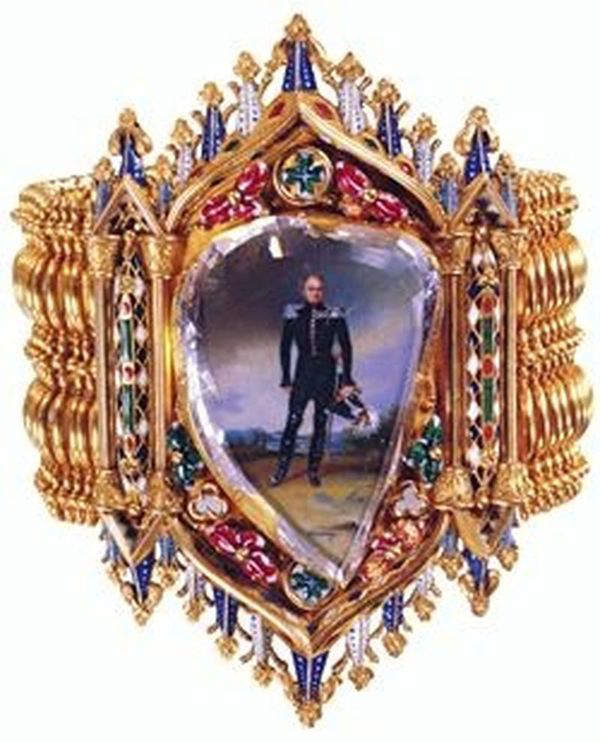
Close-up of the pear-shaped Russian Portrait Diamond covering a miniature portrait of Czar Alexander I
2) The Table-Cut Darya-i-Nur Diamond
The Darya-i-Nur diamond is a pale pink, table-cut diamond (also known as Lasque), with an estimated weight of around 186 carats, according to the GIA, and having dimensions of 41.40 x 29.50 x 12.15 mm, believed to have originated from the 242-carat, enormous, pale-pink diamond referred to as the "Diamanta Grand Table" (The Great Table Diamond) by John Baptiste Tavernier, in his book "Travels in India" - Vol II, Chapter XXII, Page 98, translated by Valentine Ball. Tavernier saw the "Diamanta Grand Table" in Golconda in 1642, during his fifth visit to the Indian sub-continent. According to the Canadian gemologists from the Royal Ontario Museum, Canada, who studied the Iranian Crown Jewels in 1966, the 186-carat, light-pink Darya-i-Nur diamond and the 60-carat, light-pink Nur-ul-Ain diamond were both derived from the same 242-carat "Diamanta Grand Table."

Table-cut Darya-i-Nur Diamond with Persian inscription dated 1834 A.D. surrounded by its elaborate setting
3) The Shah Jahan Table-cut Diamond
The Shah Jahan diamond is a light-pink, octagonal-shaped, table-cut/taviz-cut/lasque diamond, of Golconda origin, weighing 56.71-carats and having dimensions of 44.6 x 33 x 3.6 mm. The color and clarity of the stone is characteristic of pink diamonds originating from the Golconda region. A unique feature of the diamond, which identifies it as a gem of the Mughal Court, is the presence of a pair of drilled holes on opposite ends of the stone, which enabled the stone to be sewed on to a turban or a garment of the emperor.
The Shah Jahaan table-cut diamond is identified with a pink table-cut diamond, that weighed 60 ratis (about 54 carats), shown by the last of the Great Mughal Emperors Aurangzeb, son of Shah Jahan, to Jean Baptiste Tavernier, in 1665. This stone correlates very well with the Shah Jahaan diamond, in respect of shape, cut, clarity, color and weight.
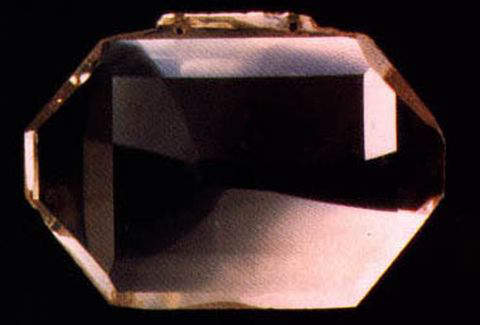
The Shah Jahan Table-Cut Diamond
The Shah Jahaan diamond like many other famous Mughal diamonds such as the Koh-i-Nur, the Darya-i-Nur, Nur-ul-Ain, the Shah diamond, etc. left India in 1739 after the sacking and plunder of Delhi and Agra by the invading forces of Nadir Shah the ruler and conqueror of Persia.
The course of migration of the diamond from Persia to a country in Europe is only a matter of speculation. However the long lost Shah Jahaan diamond suddenly made it's appearance at an auction at Christie's in Geneva in 1985, but was withdrawn from the sale as it failed to realize it's reserve.
4) The Shah Diamond
The Shah Diamond is an 88.7-carat, table-cut, light-yellow colored, Golconda diamond of exceptional clarity, associated with the Nizam Sahi dynasty of the Kingdom of Ahmednagar, in West Central India, who ruled between 1490 and 1633. The diamond is engraved in Arabic characters with the names of three rulers of India and Persia, on three of its facets. The first inscription reads - "BURHAN NIZAM SHAH II, YEAR IOOO A.H." - a reference to the second Nizam Sahi ruler, Burhan Nizam Shah II, who ruled the kingdom between 1591-1595. Year 1000 A.H. in the Hijra calendar is equivalent to 1591 A.D. in the Gregorian calendar.
After the capture of Ahmednagar by Mughal emperor Akbar the Great (1556-1605) in 1600, the Shah diamond entered the Mughal treasury and was successively inherited by Mughal emperors Jehangir (1605-1827) and Shah Jahan (1628-1658). It was Shah Jahan who ordered the second inscription "THE SON OF JEHANGIR-SHAH JAHAAN, YEAR 1051 A.H." This is equivalent to 1641 A.D.
The Shah Diamond was part of the loot plundered by the Iranian conqueror Nadir Shah, when he invaded Delhi and Agra in 1739 A.D. After Nadir Shah's assassination in 1747 most of the treasures in the Iranian treasury were either plundered by the revolting troops or fell into the hands of three rival rulers who emerged in a splintered Iranian kingdom. Finally only one ruler, the founder of the Qajar dynasty, Agha Muhammad Khan Qajar prevailed, who succeeded in re-assembling at least partially the scattered Crown Jewels of Iran. The Shah Diamond was among the treasures that were restored. When Agha Muhammad Khan Qajar died in 1797, the Shah Diamond was inherited by Fath Ali Shah, who ruled the Iranian kingdom from 1797 to 1834. It was Fath Ali Shah who ordered the engraving of the third name on the Shah diamond-"THE RULER OF THE QAJAR-FATH ALI SHAH SULTAN-YEAR 1242 A.H.(1829 A.D.)
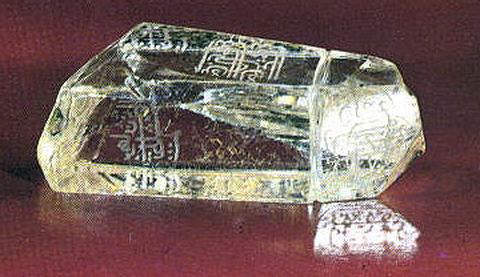
Table-Cut Shah Diamond from the Kremlin Diamond Fund
During the rule of Fath Ali Shah in 1829, the Russian Diplomat and writer Alexander Sergevich Griboedov was murdered in Teheran, the capital city of Iran. The Russian Government demanded severe punishment for those responsible for the murder. Fath Ali Shah then sent a delegation led by his grandson, Hosrov Mirza (Cosrhoes) to St. Petersburg, to meet and apologize to the Emperor of Russia, Czar Nicholas I, over the unfortunate death of the diplomat. During this visit Hosrov Mirza also presented a valuable gift to the emperor from the ruler of Iran, Fath Ali Shah. This gift was none other than the valuable diamond the "Shah Diamond". This is how the Shah Diamond entered the collection of the Kremlin Diamond Fund.
5) The Taj Mahal Diamond
The Taj Mahal diamond is a heart-shaped, table-cut, flat diamond, known technically as Lasque. The table-cut or lasque is an ancient Indian cut, in which the diamond was cut in the form of a thin slab or sheet, of different shapes and sizes, such as rectangular, square, heart-shaped, pear-shaped etc.
The Persian Language inscription with Arabic characters on the diamond, covers almost the entire surface of the diamond. The inscription has three entries, which translated into English reads as follows :- "Nur Jahan, Begum Padshah; 23; 1037" - Nur Jahan, Lady of the Padshah; 23; 1037"
Close-up of Taj Mahal Diamond and Jade Pendant
© Christies
the heart-shaped, table-cut Taj Mahal diamond is mounted on a grey colored thick jadeite mount, also roughly heart-shaped and mounted on an enameled-gold backing; the slab of jade being secured to the setting right round by the bent edges of the gold backing, like a bezel setting. Surrounding the heart-shaped table-cut Taj Mahal diamond, after leaving a small gap on the jade mount, is another heart-shaped zone set with a single row of red gemstones. The red gemstones appear to be spinels (balas rubies), that were available in large quantities during the 17th-century and were sourced mainly from the Badakshan mines of Afghanistan. The cut on these spinels, appear to be simple rectangular table-cuts, an ancient cut employed before the development of more advanced cutting styles, with crown, pavilion, girdle and multiple facets. The rectangular spinels are placed end to end, without a gap and appear to be set on the jade mount by bezel settings. Bent gold edges run right round the two edges of the red gemstone zone similar to the outer edge of the pendant. The thick slanting edge of the heart-shaped jadeite mount, are mounted on either side, with six rhomboidal table-cut diamonds, bezel set with bent gold edges right round. The entire metal backing for the pendant is enamelled-gold. The reverse of the pendant is decorated with an enamel latticework motif. Provision for the suspenion of the pendant by a silk cord has been made in the form of two loops or rings in gold originating from the upper end of the pendant.
You are welcome to discuss this post/related topics with Dr Shihaan and other experts from around the world in our FORUMS (forums.internetstones.com)
Related :-
1)Russian Table Portrait Diamond
External Links :-
https://www.bonhams.com/press_release/10301/
References :-
1) Bonham offers important 17th-century "Mughal Mirror Diamond Necklace for private sale - May 3, 2012. Bonhams Press Release
2) The Mineral Diamond - www.minerals.net
3) The Cleavage of Diamonds - www.minelinks.com
4) Diamond Crystal Structure - www.geo.utexas.edu
5) Cleavage - From Wikipedia, the free encyclopedia
6) A History of Diamond Cutting - www.langantiques.com
Powered by Ultra Secure
Amazon (USA) Cloud Network

Founder Internet Stones.COM
Register in our Forums
| Featured In
|
|
|
|
|
|
|
|


















